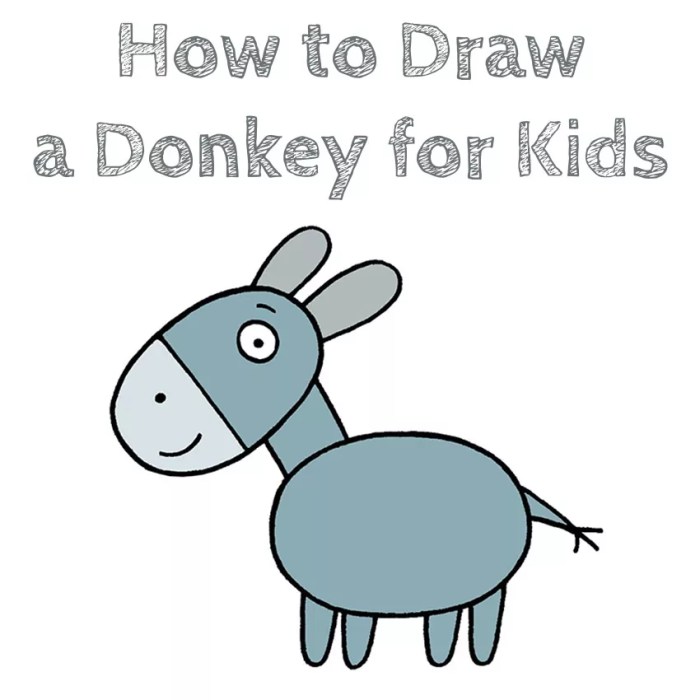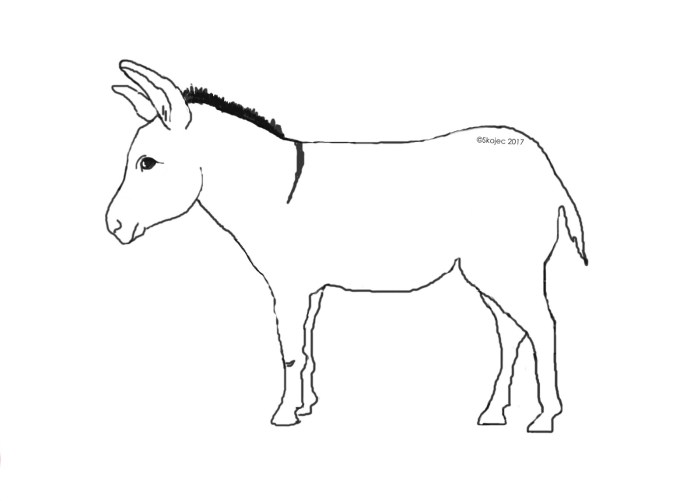Defining an “Easy” Donkey Drawing: A Easy Drawing Of A Donkey

A easy drawing of a donkey – An “easy” donkey drawing is subjective, depending on the artist’s skill level and the desired level of detail. For beginners, an easy donkey focuses on simple shapes and minimal details, while more experienced artists might incorporate more complex features and shading. We’ll explore different levels of complexity to illustrate this.
Donkey Drawing Variations
Three variations of a donkey drawing are presented below, progressing from simple to complex. Each variation offers a different level of detail and requires a varying amount of time and skill.
- Simple Donkey: This version uses basic shapes like circles, ovals, and rectangles to create a recognizable donkey. It’s perfect for beginners and requires minimal drawing skills. Think of it as a cartoon donkey – very simplified.
- Medium Donkey: This version adds more detail to the simple donkey, including more defined legs, a more expressive face, and perhaps some basic shading. It requires a slightly higher level of skill and attention to detail than the simple version.
- Complex Donkey: This version aims for realism, incorporating intricate details like individual hairs in the mane and tail, accurate anatomical proportions, and advanced shading techniques. This requires significant drawing experience and a good understanding of animal anatomy.
Step-by-Step Simple Donkey Drawing
This guide focuses on creating the simplest donkey drawing using basic shapes.
- Draw a large circle: This will form the donkey’s body.
- Add a smaller circle on top: This will be the donkey’s head.
- Attach two slightly curved lines to the bottom of the large circle: These are the donkey’s legs.
- Draw two small circles for the donkey’s ears on top of the head: Make sure they point upwards.
- Add two small, slightly oval shapes for the donkey’s eyes on the head.
- Draw a small, curved line for the donkey’s mouth.
- Draw a long, slightly curved line for the donkey’s tail, extending from the back of the body.
Comparison of Donkey Drawings
The three donkey drawings differ significantly in complexity and time required. The simple donkey, relying solely on basic shapes, can be completed in a few minutes. The medium donkey, with its added details, might take 15-20 minutes. The complex donkey, requiring detailed shading and anatomical accuracy, could take several hours or even longer, depending on the artist’s skill and desired level of realism.
The time difference reflects the increased level of detail and the technical skill needed for each version. For example, a child might complete the simple donkey quickly, while an experienced artist might spend considerably more time on the complex version, perfecting the subtle nuances of the donkey’s form.
Essential Elements of a Donkey Drawing

So, you want to draw a donkey? Awesome! Even a super-simple drawing can capture the essence of this lovable creature. The key is to focus on the most recognizable features and simplify their shapes to make the process easy and fun. We’ll break down the essential elements and show you how to build your donkey using basic shapes.The most important aspects of any donkey drawing, even a simplified one, are the features that immediately identify it as a donkey.
These key elements help create a recognizable image, even with a minimal amount of detail. Simplifying these features will be key to making this a truly “easy” drawing.
Simplified Donkey Features
To make your donkey drawing easy, we’ll focus on the most characteristic features: the large ears, the sturdy body, and the distinctive tail. Instead of getting bogged down in intricate details, we’ll use basic shapes to build these elements. This approach ensures that even a beginner can create a recognizable donkey image.
Mastering a simple donkey drawing is surprisingly satisfying; it’s all about those expressive ears and slightly grumpy face. Once you’ve conquered that, why not try your hand at equally simple subjects? Check out this guide for easy fishing stuff drawing , perfect for honing your skills before tackling more complex animal illustrations. Then, you can return to your donkey masterpiece with newfound confidence and a broadened artistic perspective!
Constructing the Donkey with Basic Shapes
Let’s start with the body. Think of the donkey’s body as a large, slightly elongated rectangle. This rectangle will form the foundation of your donkey. Now, add two slightly smaller rectangles for the legs, positioning them beneath the main body rectangle. These can be slightly angled outwards for a more natural stance.
Next, for the head, use a slightly smaller circle, connected to the main body rectangle. The ears? Two long triangles, attached to the top of the head circle. Finally, the tail. This can be a simple, slightly curved line extending from the back of the main body rectangle.
These simple shapes, when skillfully connected, create a recognizable donkey. Adding a small circle for the donkey’s eye and a curved line for the mouth will finalize your drawing.
Drawing Techniques for Beginners

So, you wanna draw a donkey? Awesome! Don’t worry about being a pro; even the simplest approach can yield a surprisingly cute result. This section will walk you through three easy pencil techniques, perfect for beginners. We’ll cover the pros and cons of each, and then tackle some common newbie mistakes. Let’s get started!
Pencil Techniques for Drawing Donkeys, A easy drawing of a donkey
Here are three distinct methods you can use to draw a donkey with just pencils. Each offers a different balance of ease, speed, and detail. Experiment to find your favorite!
| Technique Name | Description | Ease (1-5) | Speed (1-5) | Result Quality (1-5) |
|---|---|---|---|---|
| Basic Shapes | Start with simple geometric shapes (circles, squares, rectangles) to build the donkey’s body, head, and legs. Gradually refine these shapes into the donkey’s form. Use light pencil strokes for initial sketching. | 5 | 4 | 3 |
| Line Drawing | Focus on creating a continuous line drawing of the donkey’s Artikel. Don’t worry about perfect proportions initially; just capture the overall shape and posture. You can add details like the ears and tail later. | 4 | 5 | 3 |
| Value-Based Shading | Begin with a basic Artikel. Then, use shading techniques to add depth and dimension. Start with lighter tones and gradually build up darker areas to create a sense of volume. Pay close attention to light sources and how they affect the donkey’s form. | 3 | 2 | 5 |
Common Beginner Mistakes and Solutions
Beginning artists often face similar challenges when drawing animals. Understanding these common pitfalls and their solutions can significantly improve your donkey drawings.
Here’s a list of frequent mistakes and how to fix them:
- Problem: Inaccurate proportions – the head is too big, legs too short, etc. Solution: Use light guidelines to establish basic proportions before adding details. Lightly sketch simple shapes first to get the overall size and placement correct. Reference photos can be extremely helpful!
- Problem: Lack of shading and depth. Solution: Observe how light falls on a donkey. Use shading to create the illusion of volume and form. Start with light pencil strokes to establish the values, and gradually build up darker areas.
- Problem: Too much detail too soon. Solution: Focus on the overall shape and form first. Add details gradually, refining the drawing as you go. Don’t get bogged down in tiny details before you have a solid foundation.
- Problem: Using too much pressure with the pencil. Solution: Start with light pencil strokes and gradually increase pressure as needed. This allows for easy corrections and prevents smudging.
- Problem: Ignoring negative space. Solution: Pay attention to the space around the donkey. This can help you accurately place the animal and maintain correct proportions. Think about the shape the negative space makes around the donkey.
FAQ Overview
What type of pencils are best for drawing a donkey?
HB, 2B, and 4B pencils offer a good range for shading and line work. Experiment to find your preference.
How can I make my donkey drawing look more realistic?
Focus on accurate proportions, add subtle shading to create depth and volume, and pay attention to details like the texture of the fur.
What if my donkey drawing doesn’t look perfect?
Don’t worry! Art is about the process, not perfection. Embrace imperfections and learn from each attempt.
Can I use colored pencils instead of graphite?
Absolutely! Colored pencils allow you to add vibrant colors and personality to your donkey drawing.

